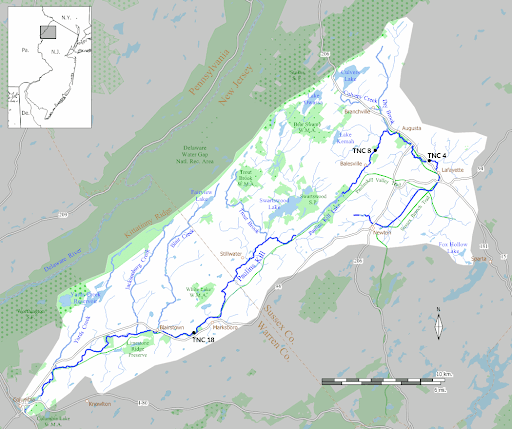The fate of forests and waterways is deeply intertwined. In fact, the US Forest Service was founded in part “for the purpose of securing favorable conditions of water flows”.

The fate of forests and waterways is deeply intertwined. In fact, the US Forest Service was founded in part “for the purpose of securing favorable conditions of water flows”. Given the integral role forests play in regulating water resources, their vulnerability amidst a changing climate has important implications for freshwater ecosystems. This case study outlines how technological innovations are empowering organizations to quantify this relationship with greater nuance to inform resilience strategies and planning.
With support from the William Penn Foundation, The Nature Conservancy’s New Jersey chapter (TNC-NJ) collaborated with Upstream Tech on a project to use satellite data and machine learning to understand future water quality implications of land cover change and warming temperatures. Recognizing the crucial role forests play in keeping waterways healthy, TNC-NJ has conserved over 58,000 acres across the state. In addition to protecting forests today, TNC-NJ wanted to understand how their reforestation actions could impact future ecosystem and habitat conditions in the Paulins Kill watershed of northwestern New Jersey.
As Ellen Creveling, Director of Policy and Science at TNC-NJ said, “Forests are critical in regulating water quality, and water temperature is particularly important for fish and other aquatic wildlife. But with the climate changing, we needed a way to understand what the expected effects would be under future conditions, so that we could act effectively to offset these risks.”
Upstream Tech’s machine learning model analyzed large datasets to understand how weather and land surface conditions interact to impact water quality. Once the model was trained to pick up on patterns in these interactions, we applied it to the Paulins Kill watershed to understand how water quality might be impacted by changing conditions such as warmer weather or forest cover.

This project evaluated the impacts of changing forest cover and rising air temperatures on dissolved oxygen and stream temperature metrics to inform reforestation efforts. More specifically, we sought to determine “What level of forest restoration could mitigate the risks to fish species given land cover change and a warming climate?” To answer this question, we first selected three stream gauge sites with the guidance of TNC-NJ staff which represented a range of different conditions within the region. Next, we chose eight scenarios, described in the table below, to capture a range of possible changes for forest cover and rising air temperature.
Each of these scenarios were evaluated in light of how they would affect habitat needs for trout and non-trout fish species during spawning and migration periods. Acceptable water quality ranges were based on the New Jersey Department of Environmental Protection (NJDEP) Surface Water Quality Standards released in 2016. To model a range of possible future forest restoration and air temperature conditions, we leveraged advancements in satellite imagery and machine learning-based hydrologic modeling.
Machine learning is a core aspect of our work at Upstream Tech, particularly in our streamflow modeling and forecasting. You can read more about this in our Machine Learning 101 piece, but in brief, this entails training models to learn relationships based on data -- in our case often satellites and other meteorological inputs. The graphic below illustrates this process for the water quality models used in this project.

Once these machine learning models were trained using instream water quality data provided by TNC-NJ and satellite and weather data for the Paulins Kill basin, we evaluated how outputs would change for hypothetical future scenarios. In other words, we changed the input values for forest cover and air temperature to reflect the eight scenarios described above. Then we compared those resulting dissolved oxygen and water temperature values with the NJDEP’s safe standards to understand what the implications would be for trout and non-trout species. Results for trout are shown in the table below, with red cells indicating a decline in water quality, and green showing improvement in how often the water quality metric fell within safe levels compared to the status quo. What this tells us is that moderate to significant forest restoration fully offsets smaller changes in air temperature and helps reduce impacts of warming air temperatures across the board.
Though we only cover a sample of the full results here, this study elucidated the relationship between basin conditions, climate, and water quality in the Paulins Kill watershed. Broadly, we showed that machine learning models are able to learn the relationships between environmental conditions and water quality. On the relationship between trees, temperature and trout, we found:
These results underscore the fundamental interconnection between forests and freshwater, and the importance of forest restoration as an adaptation strategy under future warming conditions. “This insight helps us better understand the scope of the risk so that we can work to effectively scale restoration to protect ecosystems and wildlife,” said Creveling.
Though anthropogenic climate change is often discussed on a global scale, this study highlights the localized impacts of these changes -- as air temperatures rise, the impacts on aquatic species can vary even within the same basin, and are directly influenced by adjacent forests. The effect is local, but so too is the opportunity. We’re grateful for the work of organizations like TNC-NJ in conserving and restoring the ecosystems which sustain us all.
For a deep dive on our methodology, and full results, download the full report.